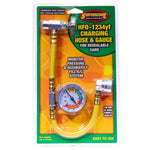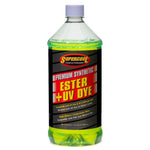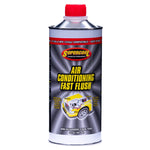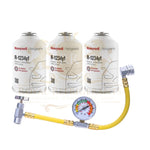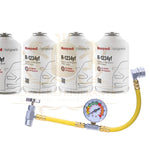You have no items in your shopping cart.
Everything You Need to Know About R-407C for HVAC and Automotive Applications
As global regulations phase out older refrigerants like R-22 due to their harmful environmental effects, the HVAC and automotive industries are turning to safer, more efficient alternatives. One of the most widely adopted replacements is R-407C.
R-407C is known for its energy efficiency, environmental friendliness, and compatibility with existing R-22 equipment (in some cases). But what exactly is R-407C, and how does it perform in both HVAC and automotive systems?
In this article, we’ll cover everything you need to know about R-407C refrigerant — its composition, properties, uses, advantages, limitations, and its role in today’s cooling technology.
What Is R-407C?
R-407C is a hydrofluorocarbon (HFC) blend refrigerant, developed as a replacement for R-22 in air conditioning and heat pump systems. It was introduced in the late 1990s as part of the global movement to reduce ozone-depleting substances (ODS).
R-407C is a zeotropic blend made up of three components:
-
R-32 (Difluoromethane) – Provides high efficiency and pressure.
-
R-125 (Pentafluoroethane) – Reduces flammability and improves stability.
-
R-134a (Tetrafluoroethane) – Enhances overall performance and compatibility.
This combination gives R-407C similar cooling properties to R-22, making it a practical retrofit option for older systems.

Key Properties of R-407C
| Property | Value/Description |
|---|---|
| Chemical Type | HFC blend (R-32/R-125/R-134a) |
| Ozone Depletion Potential (ODP) | 0 (non-ozone depleting) |
| Global Warming Potential (GWP) | ~1774 |
| Lubricant Type | Requires POE (Polyolester) oil |
| Pressure | Slightly higher than R-22 |
| Temperature Glide | Approximately 10°F (5.5°C) |
| Color | Colorless gas |
| ASHRAE Safety Class | A1 (non-flammable, low toxicity) |
How R-407C Works
R-407C operates on the same basic vapor-compression refrigeration cycle as other refrigerants. Here’s how it works in HVAC and automotive systems:
Compression:
The refrigerant gas is compressed, increasing its temperature and pressure.
Condensation:
The hot, high-pressure gas passes through the condenser coils, releasing heat and condensing into a liquid.
Expansion:
The liquid refrigerant expands through an expansion valve, dropping its pressure and cooling significantly.
Evaporation:
The cold refrigerant absorbs heat from the air (in HVAC systems) or cabin (in vehicles), turning back into gas and restarting the cycle.
This process efficiently removes heat from the air, maintaining cool and comfortable conditions.
Applications of R-407C
HVAC Systems
R-407C is primarily used in:
Residential split-type air conditioners
Commercial rooftop and ducted systems
Heat pumps
Chillers (medium-temperature)
Its thermodynamic characteristics are similar to R-22, allowing for simple retrofitting in older units with minimal hardware changes (although the lubricant must be replaced with POE oil).
Automotive Systems
While R-407C is not commonly used in modern automotive A/C systems — which rely on R-134a or R-1234yf — it can be used in mobile refrigeration or specialized vehicle HVAC units (like buses and transport trucks) designed for R-22 equivalents.
However, due to its temperature glide and higher system pressures, it is not recommended as a direct drop-in for standard car A/C systems.
Advantages of R-407C
✅ Ozone-Friendly: Zero ODP, making it environmentally safe compared to R-22.
✅ Good Cooling Performance: Similar capacity and efficiency to R-22.
✅ Retrofitting Option: Can be used in older R-22 systems with proper modifications.
✅ Non-Flammable: Classified as A1 under ASHRAE safety standards.
✅ Widely Available: Common in HVAC markets worldwide.
Disadvantages of R-407C
⚠️ High GWP: Although ozone-safe, it still has a relatively high Global Warming Potential.
⚠️ Temperature Glide: R-407C’s zeotropic nature causes uneven boiling/condensing temperatures, affecting heat transfer efficiency.
⚠️ Not Ideal for Automotive A/C: Higher operating pressures and POE oil requirement make it unsuitable for standard car systems.
⚠️ Oil Compatibility: Requires a full oil change to POE oil when retrofitting from R-22.
R-407C vs. Other Refrigerants
| Feature | R-407C | R-22 | R-410A | R-134a |
|---|---|---|---|---|
| ODP | 0 | 0.05 | 0 | 0 |
| GWP | 1774 | 1810 | 2088 | 1430 |
| System Pressure | Slightly higher than R-22 | Moderate | Higher | Lower |
| Oil Type | POE | Mineral | POE | PAG |
| Drop-in Replacement for R-22 | Partial | — | No | No |
| Primary Use | HVAC | HVAC | HVAC | Automotive |
Environmental Impact and Regulations
R-407C is a significant improvement over R-22 because it does not harm the ozone layer. However, due to its high GWP, many countries are gradually phasing it down under global agreements like the Kigali Amendment to the Montreal Protocol.
Future refrigerants with lower GWP, such as R-32, R-454B, and natural alternatives like CO₂, are expected to replace R-407C in new systems over the next decade.
Safety and Handling Guidelines
-
Always handle R-407C in well-ventilated areas.
-
Use protective gloves and eyewear during maintenance.
-
Avoid mixing with other refrigerants.
-
Recover and recycle refrigerant properly — never vent into the atmosphere.
-
Use approved gauges, hoses, and recovery machines rated for R-407C pressures.
Future of R-407C in Cooling Technology
While R-407C remains a popular transitional refrigerant, it is gradually being replaced by R-32 and R-454B, which offer similar performance with lower environmental impact.
For existing HVAC systems, R-407C continues to be a cost-effective and efficient solution, but new installations are shifting toward next-generation refrigerants that align with sustainability goals.
Conclusion
R-407C has played a vital role in the global transition away from ozone-depleting refrigerants like R-22. It offers strong performance, reliability, and environmental benefits for HVAC systems — though its use in automotive applications remains limited.
As the industry continues to evolve, eco-friendly and energy-efficient alternatives will define the future of both HVAC and automotive air conditioning. Still, understanding R-407C helps technicians, engineers, and consumers make smarter, more sustainable cooling decisions.
 English
English

